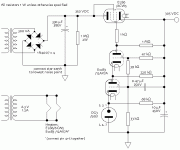I have a 500V center tapped transformer (Hammond 269JX) that I plan on using in the following circuit... but I'm struggling with how to wire the secondary for 250V. If I wire one red wire with the CT red/yellow, I get 250V, but isn't it detrimental to the transformer to leave the other red wire unconnected?
Attachments
...but isn't it detrimental to the transformer to leave the other red wire unconnected?
No. You may use either half of the secondary alone without harm to it provided the current capacity is adequate.
You can use a center-tap full wave circuit and get about 40% more current or 40% less voltage drop. See: http://www.hammondmfg.com/pdf/5c007.pdf
You can use a center-tap full wave circuit and get about 40% more current or 40% less voltage drop. See: http://www.hammondmfg.com/pdf/5c007.pdf
Actually, this is what I was looking for. Thanks.
To clarify:
If your transformer is actually a centertapped 500V secondary, you will want to rectify either half of the secondary with a sand fullwave bridge, given that the current rating of the half (same as the stated rated) is sufficient.
If it is in fact two 250V secondaries which may be independently addressed, the best course is to use them in parallel with the same sand bridge, for twice rated current. You may also connect them in series and use a fullwave rectifier to the same result, but be aware; each of the diodes in the fullwave 'sees' the full peak voltage (740V or so) of the winding as its reverse voltage, so use 1KV diodes. Sand diodes may be overdrawn in current briefly, but they will tolerate no overvoltage before the blue smoke escapes.
How do I know this, hm?
Poinz
AudioTropic
If your transformer is actually a centertapped 500V secondary, you will want to rectify either half of the secondary with a sand fullwave bridge, given that the current rating of the half (same as the stated rated) is sufficient.
If it is in fact two 250V secondaries which may be independently addressed, the best course is to use them in parallel with the same sand bridge, for twice rated current. You may also connect them in series and use a fullwave rectifier to the same result, but be aware; each of the diodes in the fullwave 'sees' the full peak voltage (740V or so) of the winding as its reverse voltage, so use 1KV diodes. Sand diodes may be overdrawn in current briefly, but they will tolerate no overvoltage before the blue smoke escapes.
How do I know this, hm?
Poinz
AudioTropic
- Status
- Not open for further replies.
